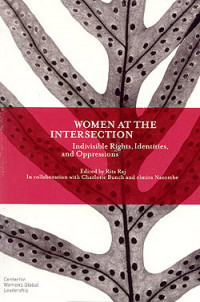
Text
Women at the intersection : indivisible rights, identities, and oppressions
There is an indivisible connection between the many overlapping aspects of women's identities - race, ethnicity, class, national origin, ability, sexual orientation, etc. - the kinds of oppressions they experience - racism, xenophobia, poverty etc. - and the human rights to which they are entitled - civil and political, economic and social rights. It is critical for all those interested in women's human rights to explore and articulate these connections as a part of their work to build an environment in which all women can fully enjoy all of their human rights. It is these connections that are the subject matter of the pages that follow. In order to understand these connections, we propose the use of a methodology that shines a light on the differences and variations that make up the rich fabric of who women are in both their individual and collective identities while also highlighting how these differences can be used against them to perpetuate privilege and power. We call this methodology an intersectional human rights methodology because its purpose is to make plain the connections or intersections that can have such an important effect on the enjoyment of our human rights. The World Conference Against Racism (WCAR) provided a unique opportunity to explore and make visible the connections just described. On August 31, 2002 in Durban, South Africa, the Global Center and its partners convened a women's human rights hearing entitled "Women at the Intersection of Racism and Other Forms of Oppression" as a part of its activities at the conference. The hearing involved 15 women from 12 different countries. The testimonies bore witness to the fact that women often experience, at the same moment, human rights abuse that is rooted in several different aspects of their identity: race, sex, class, age, ethnicity, citizenship status, sexual orientation, etc. Women are not the only ones to experience overlapping and compounding discrimination, but women's experiences of this discrimination are often different from men's experience. It was the goal of the hearing to give visibility to women's experiences of these intersections, but also to tell the stories of some of the innovative strategies that women are using to struggle against racism and other oppressions.
Availability
| KP.1.000206 | KP.1 RAJ w | My Library | Available |
Detail Information
- Series Title
-
-
- Call Number
-
KP.1 RAJ w
- Publisher
- New Jersey : Center for Women's Global Leadership., 2002
- Collation
-
ix, 141p. ; 24 cm.
- Language
-
English
- ISBN/ISSN
-
0971141215
- Classification
-
KP.1
- Content Type
-
-
- Media Type
-
-
- Carrier Type
-
-
- Edition
-
-
- Subject(s)
- Specific Detail Info
-
-
- Statement of Responsibility
-
-
Other version/related
No other version available
File Attachment
Comments
You must be logged in to post a comment
 Computer Science, Information & General Works
Computer Science, Information & General Works  Philosophy & Psychology
Philosophy & Psychology  Religion
Religion  Social Sciences
Social Sciences  Language
Language  Pure Science
Pure Science  Applied Sciences
Applied Sciences  Art & Recreation
Art & Recreation  Literature
Literature  History & Geography
History & Geography